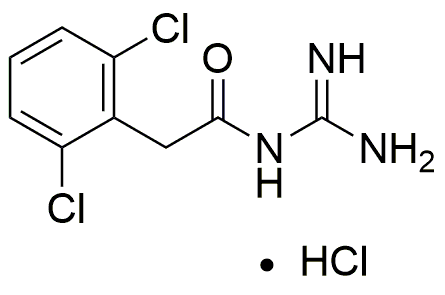Guanfacine hydrochloride is widely utilized in research focused on:
- Attention Deficit Hyperactivity Disorder (ADHD) Treatment: This compound is primarily used in the management of ADHD, providing an alternative to stimulant medications. It helps improve attention and reduce impulsivity in children and adolescents.
- Hypertension Management: Guanfacine hydrochloride is effective in lowering blood pressure, making it a valuable option for patients with hypertension, particularly those who may not tolerate other medications well.
- Behavioral Disorders: It is also applied in treating behavioral issues associated with conditions like autism spectrum disorder, helping to manage symptoms such as irritability and aggression.
- Research in Neuropharmacology: The compound is used in studies to understand its effects on the central nervous system, contributing to the development of new therapeutic strategies for various neurological conditions.
- Comparative Effectiveness Studies: Guanfacine hydrochloride is often included in clinical trials assessing the efficacy of non-stimulant medications, providing insights into its benefits over traditional stimulant treatments.
General Information
Properties
Safety and Regulations
Applications
Guanfacine hydrochloride is widely utilized in research focused on:
- Attention Deficit Hyperactivity Disorder (ADHD) Treatment: This compound is primarily used in the management of ADHD, providing an alternative to stimulant medications. It helps improve attention and reduce impulsivity in children and adolescents.
- Hypertension Management: Guanfacine hydrochloride is effective in lowering blood pressure, making it a valuable option for patients with hypertension, particularly those who may not tolerate other medications well.
- Behavioral Disorders: It is also applied in treating behavioral issues associated with conditions like autism spectrum disorder, helping to manage symptoms such as irritability and aggression.
- Research in Neuropharmacology: The compound is used in studies to understand its effects on the central nervous system, contributing to the development of new therapeutic strategies for various neurological conditions.
- Comparative Effectiveness Studies: Guanfacine hydrochloride is often included in clinical trials assessing the efficacy of non-stimulant medications, providing insights into its benefits over traditional stimulant treatments.
Documents
Safety Data Sheets (SDS)
The SDS provides comprehensive safety information on handling, storage, and disposal of the product.
Product Specification (PS)
The PS provides a comprehensive breakdown of the product’s properties, including chemical composition, physical state, purity, and storage requirements. It also details acceptable quality ranges and the product's intended applications.
Certificates of Analysis (COA)
Search for Certificates of Analysis (COA) by entering the products Lot Number. Lot and Batch Numbers can be found on a product’s label following the words ‘Lot’ or ‘Batch’.
*Catalog Number
*Lot Number
Certificates Of Origin (COO)
This COO confirms the country where the product was manufactured, and also details the materials and components used in it and whether it is derived from natural, synthetic, or other specific sources. This certificate may be required for customs, trade, and regulatory compliance.
*Catalog Number
*Lot Number
Safety Data Sheets (SDS)
The SDS provides comprehensive safety information on handling, storage, and disposal of the product.
DownloadProduct Specification (PS)
The PS provides a comprehensive breakdown of the product’s properties, including chemical composition, physical state, purity, and storage requirements. It also details acceptable quality ranges and the product's intended applications.
DownloadCertificates of Analysis (COA)
Search for Certificates of Analysis (COA) by entering the products Lot Number. Lot and Batch Numbers can be found on a product’s label following the words ‘Lot’ or ‘Batch’.
*Catalog Number
*Lot Number
Certificates Of Origin (COO)
This COO confirms the country where the product was manufactured, and also details the materials and components used in it and whether it is derived from natural, synthetic, or other specific sources. This certificate may be required for customs, trade, and regulatory compliance.


